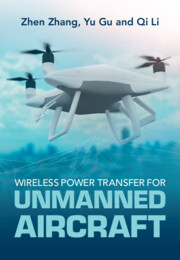Book contents
- Wireless Power Transfer for Unmanned Aircraft
- Wireless Power Transfer for Unmanned Aircraft
- Copyright page
- Contents
- Acknowledgements
- 1 Fundamentals of Wireless Power Transfer
- 2 Hovering Wireless Charging for UAVs
- 3 Magnetic Coupler Design for Wireless Charging of UAV
- 4 Control for Wireless Charging of UAVs
- 5 Control Scheme based on the PT-Symmetric WPT System
- 6 Charging Range Extension for the PT-Symmetric WPT System
- Index
- References
5 - Control Scheme based on the PT-Symmetric WPT System
Published online by Cambridge University Press: 10 October 2025
- Wireless Power Transfer for Unmanned Aircraft
- Wireless Power Transfer for Unmanned Aircraft
- Copyright page
- Contents
- Acknowledgements
- 1 Fundamentals of Wireless Power Transfer
- 2 Hovering Wireless Charging for UAVs
- 3 Magnetic Coupler Design for Wireless Charging of UAV
- 4 Control for Wireless Charging of UAVs
- 5 Control Scheme based on the PT-Symmetric WPT System
- 6 Charging Range Extension for the PT-Symmetric WPT System
- Index
- References
Summary
This chapter introduces control schemes based on the PT-symmetric wireless power transfer (WPT) system. It begins with an overview of PT symmetry and its relevance to WPT, followed by detailed models and analyses based on circuit theory and coupled-mode theory. The chapter explores the output characteristics of PT-symmetric systems and presents control methods for optimizing output power through load identification. Experimental results are provided to validate the proposed control schemes, demonstrating their effectiveness in managing power transfer and enhancing system performance. The chapter highlights the innovative aspects of PT-symmetric WPT and its potential applications.
Keywords
Information
- Type
- Chapter
- Information
- Wireless Power Transfer for Unmanned AircraftFundamentals, Design, and Control, pp. 70 - 95Publisher: Cambridge University PressPrint publication year: 2025
References
Accessibility standard: Inaccessible, or known limited accessibility
Why this information is here
This section outlines the accessibility features of this content - including support for screen readers, full keyboard navigation and high-contrast display options. This may not be relevant for you.Accessibility Information
Content Navigation
Allows you to navigate directly to chapters, sections, or non‐text items through a linked table of contents, reducing the need for extensive scrolling.
Provides an interactive index, letting you go straight to where a term or subject appears in the text without manual searching.
Reading Order & Textual Equivalents
You will encounter all content (including footnotes, captions, etc.) in a clear, sequential flow, making it easier to follow with assistive tools like screen readers.
You get concise descriptions (for images, charts, or media clips), ensuring you do not miss crucial information when visual or audio elements are not accessible.
You get more than just short alt text: you have comprehensive text equivalents, transcripts, captions, or audio descriptions for substantial non‐text content, which is especially helpful for complex visuals or multimedia.
Visual Accessibility
You will still understand key ideas or prompts without relying solely on colour, which is especially helpful if you have colour vision deficiencies.
You benefit from high‐contrast text, which improves legibility if you have low vision or if you are reading in less‐than‐ideal lighting conditions.
